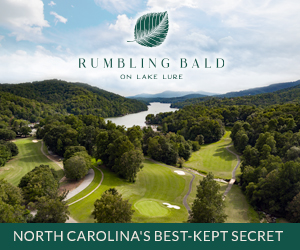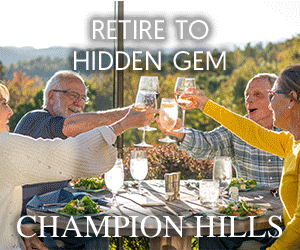By David Droschak
Golf course architects are handed varying degrees of landscapes in which to build and design layouts – some good, some challenging and then some that are quite simply spectacular settings.
The Sound at Albemarle Plantation in Hertford would fall under the latter category with its panoramic views of the expansive water, cypress trees draped in moss, along with endless “fingers” of marshes and wetlands that weave their way in and out of this Dan Maples 1990 design, teasing your golf strategy taste buds at seemingly every turn.
“The first time I came out there I was like, ‘Holy smokes.’ You just knew it was going to be great,” said Maples, who Triangle Golf Today readers know from his popular designs at The Pit, Longleaf and Little River in the Sandhills. “Albemarle Sound has these little islands you have to play to – like little dominos of golf shots.”
For Maples, who is one architect who takes great pleasure in designing cart paths that take you on mini tours of the course, Albemarle Plantation must have been utopia. There are 30 bridges dotting the course that connect pieces of scenic marsh to push green fairways.
A ride along the one mile of wooden bridges is a treat in itself.
Then there is the golf course, which starts out rather docile and then quickly becomes a test of accurate golf more than length, considering Albemarle Plantation plays just 6,431 yards from the tips.
Still, you’re able to hit your driver seven or eight times, and more if you’re willing to “walk the plank,” so to speak.
For example, four of the par-4s measure 322 yards or less, but miss in an attempt to drive Nos. 8, 9, 15 and 16 and you’re staring double bogey in the face.
“You can try to needle something in there,” said head pro Craig Clarkson. “You have an opportunity to hit some golf shots here. Even though they are short holes, they still pose a challenge each time you play them.”
Much of the difficulty in this layout is placed in three of the par-3s, which measure more than 200 yards each from the back tees.
The sixth hole, in particular, will catch your attention at 235 yards. It requires a long iron or 3-wood shot over a series of marshes to a flag that is a stretch to see over the summertime 6-foot high cattails.
It is one of the more beautiful and testy par-3s in all of North Carolina.
“It’s a unique setting on the tee boxes because it feels like you’re hitting directly out of the marsh,” Clarkson said. “When you’re faced with a forced carry of over 190 yards, and you’re standing in the cattails plants, a lot of nerves come into play on that shot.”
Other than arriving at the clubhouse, which is being renovated and will re-open this fall, the first glimpse of the majestic Albemarle Sound is the backdrop of the eighth hole. The views of the sound then open up 100 percent on the short dogleg ninth before the final water stretch of holes spanning 16-18, which also offer a dramatic view of the club’s marina filled with boats, and a few bald eagle nests.
“When you get to No. 16 and you see the sound and the marina it’s as if the hole is endless because the view seems to go on forever and ever,” Clarkson said. “There are not too many places nowadays that have those kinds of views from a golf course. A lot of attention was paid in the design of the course to keep those open spaces. You can’t beat that stuff.”
“There are just beautiful holes build on the sound,” added Maples. “The 18th hole is a little dogleg with bulkhead all the way down the right side. It’s like Pebble Beach – you can bite off as much as you want to. People just go out there and fall in love with it.”
Maples recalls the challenge of building the clubhouse. Many construction and design folks argued that the site was too unstable to erect a three-story building with picturesque views of the sound. So Maples dug down 10 feet into the ground and hauled in massive amounts of clay to form a sturdy foundation.
“That’s where everybody goes now for a hurricane because it’s built like a fort,” Maples joked.
Speaking of weather – Albemarle Plantation will likely play differently each time you tee it up, considering the wind direction off the sound.
“The weather does pose a unique challenge at times,” Clarkson said. “This course definitely holds your interest.”
Albemarle Plantation is a perfect stop heading to or returning from the northern portion of Outer Banks, or can serve as a nice day-trip diversion from the crowded courses and summer heat of the Triangle. A round with cart and range balls costs just $54, with additional discounts found as low as $40.
It’s really unhurried golf at a great price point.
“So you pretty much can get a tee time any time,” Clarkson said. “And our course is tournament ready all the time as far as being in shape. Our price points are so much lower than at the beach and playing with the crowds. That’s a huge selling point for us. It’s a country-club style course that’s open to the public.”
And a development that is likely to improve soon. Led by Triangle-based real estate mogul Steve Stroud, a small group of investors purchased the golf course and remaining property of the gated community in July 2009, along with a huge tract of land that runs along the Perquimans River that in 5-8 years could be home to another golf course and 2,200 more property owners.
“It’s pretty unique,” Maples said of Albemarle Plantation. “It’s one of a couple of courses that people think are my best. There are so many pretty holes out there. It’s absolutely gorgeous.”
And with an attractive price point to match.

















